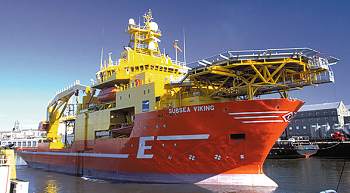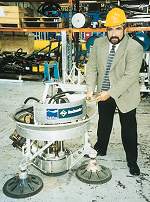 'intelligent' ROV tools After a quick drive over to East Tullos, I was met by Dave "Jock" Nicol, ROV Tooling Project Manager of the Remote Technology Group (RTG), and I later met Murray Dick, the Manager of the RTG. I was given a tour of the UK headquarters at the Greenwell Base, which includes extensive workshops and testing facilities. I was also able to visit the diving department at Wellheads Industrial Estate, Dyce. This is what I gathered. Halliburton Subsea has evolved since the merger of Halliburton and Dresser, bringing together the individual and complementary strengths of Rockwater and SubSea Offshore. Rationalisation of the widely-spread sites and facilities is on-going. Following the recent merger of Halliburton with Dresser, it claims to be the biggest energy solutions provider in the world, employing some 6000 staff in Britain alone, and 100,000 worldwide in more than 120 countries. Halliburton's consolidated revenues in 1999 were $14.9 billion. The Remote Technology Group has a uniquely successful formula of expertise within Halliburton. The group represents one of Halliburton's great strengths, and provides a means of exploiting a market which is developing towards ever-increasing water depths.
Despite the 1998 oil price crisis, business has been gradually building up over the past two years, with operations in the North Sea, Gulf of Mexico, Brazil, Africa and the Far East. This year's operations started in March, and currently every ROV is at work offshore. The company anticipates that its resources will be fully utilised next year. Halliburton Subsea operates a substantial fleet of subsea support vessels, though as we go to press we have learnt that its largest vessel, MPSV Regalia, has just been sold to ProSafe ASA in Norway. This leaves the two smaller semi-submersibles Semi 1 and Semi 2. These 63m by 49m vessels can operate in DP or with a six-point mooring system. Both operate two-bell diving systems rated to 350msw. They are complemented by two monohull MPSVs - Rockwater 1 (loa 98.35m) and Rockwater 2 (loa 118.55m), which have 18 and 16-man (respectively), single bell diving systems rated to 300 msw. Next comes Toisa Polaris, a flexible lay/diving support vessel (loa 113.57m) with an 18-man, two-bell diving system rated to 300 msw as well as a Pioneer work-class ROV and Seaeye Puma eyeball ROV. The fleet is also bolstered by two chartered DP vessels, the MPSV Subsea Viking (loa 103m), fitted with two work-class ROVs and one observation-class ROV, and the global deep-water support vessel Toisa Perseus (loa 113.57m), fitted with two Hercules work-class ROVs. The Halliburton website is at www.halliburton.com |
© 2000 Underwater World Publications Ltd.

